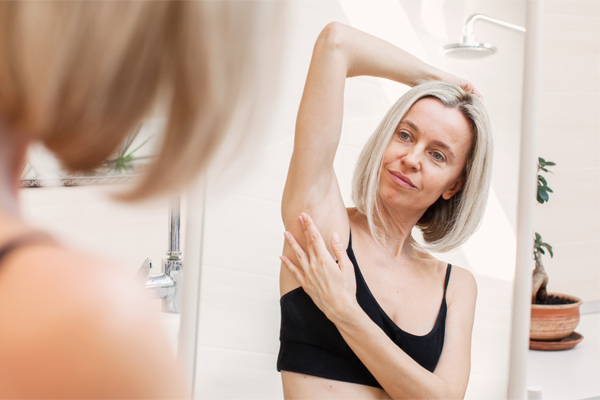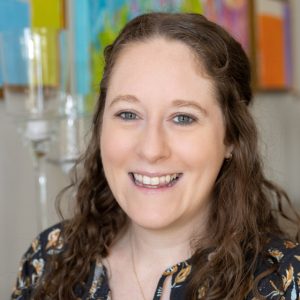Dr. Katy Sanderson discusses the latest recommendations regarding breast self-exams as well as how to perform one, what to look for, and what to do if you find something.
To self-breast exam or not to self-breast exam?
There is debate among many of the professional organizations over whether women should conduct self-breast exams or not. With anything, there are pros and cons!
The biggest benefit: in women under 50 years old, up to 71% of breast cancers were detected by women themselves during self-breast exams. In women over 50 years old, up to 50% of breast cancers were detected during self-breast exams.
The downside is that self-breast exams can lead to anxiety and extra testing in some women, which is why organizations like the American College of Obstetricians and Gynecologists now recommend “breast self-awareness” over breast self-exams.
However, if you ask your friendly neighborhood gynecologist, many of us still recommend breast self-exams because of the potential for early detection of breast cancer.
We’ve written this blog to help you gain a better understanding of the purpose of self-breast exams and what to look for as well as to inspire peace of mind. Our goal is to arm you with the facts you need to make the best choice for your breast health.
Continue reading to learn what you need to know before you conduct a breast self-exam.
What is a self-breast exam?
There is a lot of terminology out there about self-breast exams versus breast self-awareness versus clinical breast exams. This can be super confusing!
To summarize the American College of Obstetricians and Gynecologists:
- Breast self-examination is the routine checking of your breasts with the purpose of detecting breast cancer.
- Breast self-awareness is just being acquainted with and attuned to changes with your breasts.
- A clinical breast exam is part of your routine annual gynecology visit done by your physician or provider in the office.
Self-breast exams, or breast cancer self-exams, help women become more familiar with the look and feel of their breasts. Regular self-breast exams are a way of achieving breast self-awareness. Since all breasts and bodies are unique, you are the individual best equipped to spot an anomaly in your breasts.
By looking at and feeling your breast tissue regularly, you will begin to understand what “normal” looks like for you. If something changes, you will be able to spot it early. As a result, you can quickly and efficiently pursue the help you need.
In the case of breast cancer, this early detection can literally save your life!
How often should you do a self-breast exam?
Women should begin performing monthly self-breast exams once they start their menstrual period. Ideally, women would perform the exam a few days after their period ends (if they are still having periods). Your hormone fluctuation during your menstrual cycle causes changes in your breast tissue, and the week following your period is when your breasts are usually the least tender and swollen. This is the best time to notice any breast changes that may not be due to normal hormonal fluctuations.
If you are no longer having menstrual cycles, then pick a random day of the month like the 1st or the 15th to stay consistent! Pro tip: Try setting a monthly reminder in your phone!
How to Do a Self-Breast Exam: Instructions & Tips
A breast self-exam involves two inspections: a visual inspection and a physical inspection.
Visual Breast Inspection
Most women perform their visual breast inspection in front of a mirror. Remove your shirt and bra and keep your arms at your sides. Take note of the shape, color, and texture of your breasts and nipples so that you can notice if any changes occur. You should also apply gentle pressure to your nipple during your visual examination. Look for any discharge or bleeding. If you notice any, report it to your healthcare provider as soon as possible.
Physical Breast Inspection
During a physical breast inspection, while still standing up in front of a mirror, you will touch your breasts to feel for any lumps or abnormalities. Use the flat part of your ring, middle, and index finger to press into your breast and armpit area. Use a range of pressures, from gentle to firm.
You’re feeling for anything that feels out of the ordinary. This includes unusually thick areas or general changes in texture.
Next, you’ll perform a physical breast inspection while lying down. Lay flat on your back with your chest toward the ceiling. In this position, your breast tissue will naturally spread out. Most women perform this inspection lying on a bed.
Begin by placing a pillow under your shoulder on one side of your body. Place the arm on that side of your body behind your head. Use the flat part of your ring, middle, and index finger on the opposite hand to perform the inspection. As in the visual inspection, examine the entire breast and armpit using a range of pressures.
What does breast cancer feel like?
It can be helpful to know what breast cancer might feel like when you’re conducting a breast self-exam. We often hear about “lumps” – but these masses can vary widely in size, shape, and texture.
Women with breast cancer have described their lumps as feeling like a green pea, a grape, a marble, or a golf ball. A breast cancer lump might feel firm or mushy. It might have defined edges, or it might not.
The main thing to look for is whether something feels abnormal compared to what your breasts normally feel like to you. If you practice breast self-awareness through regular breast self-exams, you’ll learn what your “normal” is – so that you can tell if it isn’t.
What if I find a lump in my breast?
If you do notice an abnormality during your self-breast exam, contact your healthcare provider. With that said, not every lump or change is cancer. There are many reasons you might notice a change in your breast tissue, and most aren’t emergencies.
According to Johns Hopkins Medicine, changes to your breasts can be caused by:
- A pocket of puss called an abscess that can affect anyone
- A small sac of fluid called a cyst, common during menopause
- A rubbery, free-moving lump called a fibroadenoma, common in women of all ages
- Fat necrosis, which can form a lump in the breast following an injury and usually goes away on its own
- Blocked milk ducts while breastfeeding
- Sclerosing adenosis, which can cause small, painful, but non-cancerous lumps
Likewise, your breast tissue can sometimes change due to hormone fluctuations. You might notice changes to your breasts during your menstrual cycle (which is why we recommend doing self-breast exams a few days after your period), after you become pregnant, or while breastfeeding.
Do you still need a mammogram?
Should you schedule a mammogram even if you don’t notice any abnormalities during your self-breast exam? Yes!
A mammogram is an X-ray of breast tissue. While self-breast exams and breast self-awareness can sometimes help detect breast cancer symptoms at home, they should not replace regular screening mammograms. Mammograms can detect cancer before most women can see or feel it. Likewise, they can reveal very early signs of cancer, allowing for proactive treatment and active monitoring. Just like self-breast exams, regular mammograms can save your life.
The professionals at Yale Medicine and the American College of Obstetricians and Gynecologist recommend that women begin scheduling screening mammograms at about the age of 40. If you have a family history of breast cancer, your doctor might recommend scheduling them earlier. The latest guidance suggests women should receive a preventative mammogram every year through the age of 74. However, there is no upper age limit on screening mammograms. Since age is the greatest risk factor for developing breast cancer, many gynecologists recommend continuing screening mammograms throughout your life.
If you notice an abnormality during your breast self-exam, your physician will likely recommend a diagnostic mammogram. These tests may take somewhat longer than a screening mammogram, as the technician will need to take more X-rays.
Your doctor might also order a non-invasive exam called a breast ultrasound or breast MRI. There is no need to panic if your doctor orders one of these follow-up tests. Breast ultrasounds and breast MRI’s are also common for women with dense breast tissue.
Learn more about what a radiologist wants you to know about mammograms.
Schedule Your Mammogram Appointment
The team at Virginia Physicians for Women is happy to answer questions about self-breast exams, clinical breast exams, or mammograms. A combination of these efforts gives you a better chance of detecting breast cancer in its early stages, when it’s most treatable.
When was your last screening mammogram? Consider scheduling an appointment. Prioritizing your breast health could save your life!
To make an appointment with an OB/GYN provider at one of our Richmond, VA, locations, call VPFW at 804-897-2100 or message us to schedule online.

